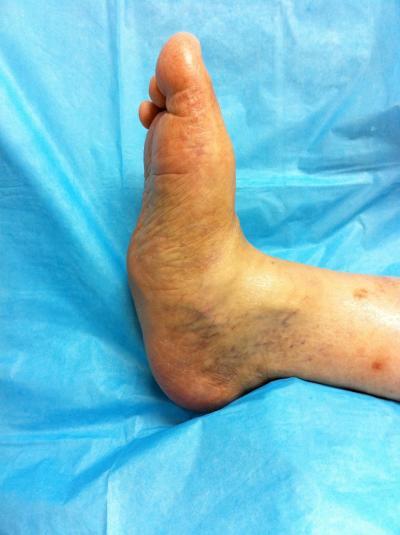Van Nuys, CA—Robert Winkler says he limped around on his painful left foot for six months, suffering unnecessarily from a misdiagnosis by a physician who didn't know about the symptoms and treatments for Charcot foot, a form of localized osteoporosis linked to diabetes that causes the bones to soften and break, often resulting in amputation.
When his primary care physician finally agreed to Mr. Winkler's request for an x-ray, they discovered the metatarsal bones in Mr. Winkler's left foot were all broken—a common symptom of this serious and potentially limb-threatening lower-extremity complication.
A new article in the September issue of the journal, Diabetes Care, describes Charcot foot and its treatment with a goal of educating medical professionals about this painful inflammation of the foot. The article is the product of an international task force of experts convened by the American Diabetes Association and the American Podiatric Medical Association in January to summarize available evidence on the pathophysiology, natural history, presentations and treatment recommendations for Charcot foot syndrome.
"Even though it was first described in 1883, the diagnosis and successful treatment of Charcot foot continue to be a challenge because this syndrome is not widely known or understood by the broader medical profession," said Lee C. Rogers, D.P.M., co-director of the Amputation Prevent Center at Valley Presbyterian Hospital in Van Nuys, CA, and lead author of the Diabetes Care article. "Charcot foot is now considered to be an inflammatory syndrome most often seen in patients with diabetes which can be successfully treated in its early stages."
The article describes Charcot foot as a condition affecting the bones, joints and soft tissues of the foot and ankle, which is characterized by inflammation in the earliest phase and is associated with diabetes and neuropathy. The report finds offloading, or removing weight from the foot, is the most important initial treatment recommendation. Surgery can be helpful in early stages involving acute fractures of the foot or ankle or in later stages when offloading is ineffective, according to the article.

Photo of patient with Charcot foot, a syndrome described in a new journal article by Dr. Lee C. Rogers at Valley Presbyterian Hospital in Van Nuys, CA. Charcot foot syndrome causes the bones in the foot to soften and break, often resulting in amputation.
(Photo Credit: Dr. Lee C. Rogers, Valley Presbyterian Hospital, Van Nuys, CA)
In Mr. Winkler's case, he was first diagnosed with Charcot foot in 2004 and had already undergone one surgery that relieved the problem for several years. By 2010, though, he was facing the potential amputation of the foot because of complications associated with Charcot foot syndrome.
His podiatrist referred him to Dr. Rogers at Valley Presbyterian Hospital's Amputation Prevention Center, an integrated limb salvage center that is one of only a handful in the nation. Since its December 2009 opening, the Amputation Prevention Center's specialized multidisciplinary team of highly skilled professionals has treated patients from all over the country and around the world with leading-edge technology, achieving a limb salvage rate of 96 percent.
George Andros, M.D., the Center's Medical Director, performed vascular surgery to restore circulation to Mr. Winkler's left foot so that it would heal. Then, Dr. Rogers performed surgery to rebuild the bones in Mr. Winkler's foot. Dr. Rogers also implanted a bone stimulator that acts like a pacemaker for bones which encourages Mr. Winkler's body to rebuild and fuse the broken bones in his left foot. As a result, Mr. Winkler is expected to be able to recover the use of his left foot.
"I'm very pleased because I had gone to another doctor and he wanted to amputate my foot," Mr. Winkler said. "When I found Dr. Rogers and Valley Presbyterian Hospital's Amputation Prevention Center, it's like I found a blessing and an angel in disguise. I have tears running down my face as I describe to you how I will be able to get up out of my chair and walk because of the care I received at Valley Presbyterian Hospital. All the people there are superb. They treat me like a king."
Source: Valley Presbyterian Hospital